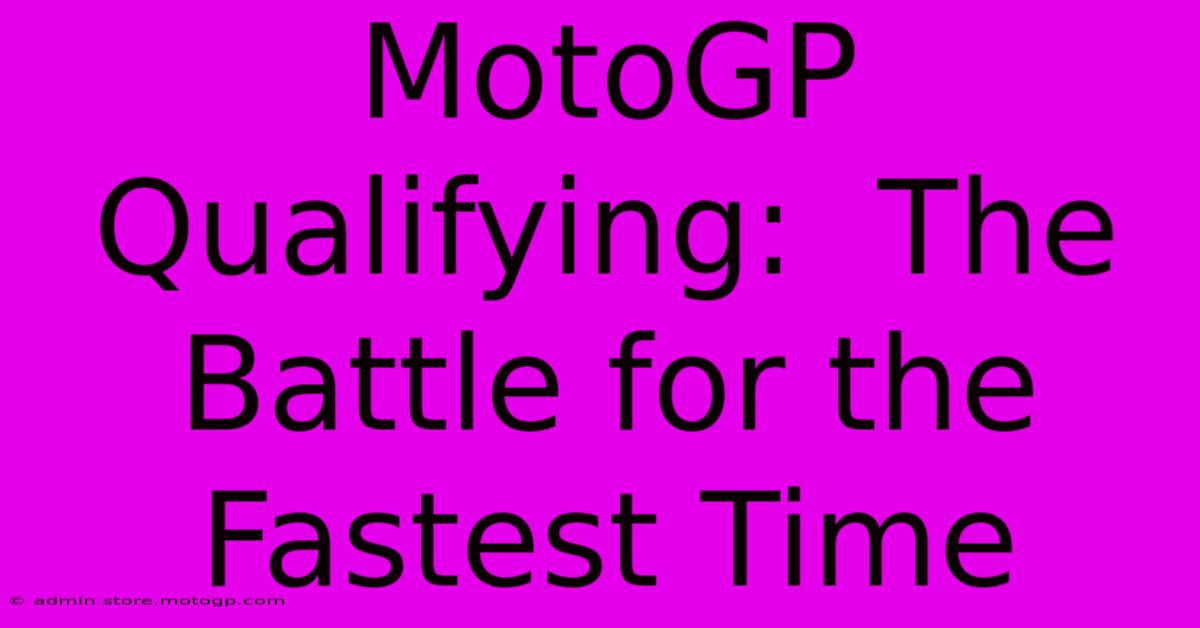MotoGP Qualifying: The Battle For The Fastest Time

Table of Contents
MotoGP Qualifying: The Battle for the Fastest Time
MotoGP qualifying is a crucial stage in the Grand Prix weekend, determining the all-important starting grid positions for the race. It's a high-stakes, nail-biting spectacle where the world's best motorcycle racers fight tooth and nail for that coveted pole position. This article delves into the intricacies of MotoGP qualifying, explaining its format, the strategies employed, and the factors that contribute to a rider's success.
Understanding the Qualifying Format
The current MotoGP qualifying format is designed to maximize drama and ensure the fastest riders are rewarded with the best starting slots. It typically unfolds over two sessions:
Q1 (Qualifying 1):
- Participants: The riders who finish outside the top ten in the combined Free Practice times participate in Q1.
- Duration: 15 minutes of intense action.
- Objective: The top two riders from Q1 progress to Q2. This is a fierce battle, as every millisecond counts.
Q2 (Qualifying 2):
- Participants: The top ten riders from the combined Free Practice sessions automatically qualify for Q2, along with the two fastest riders from Q1.
- Duration: 15 minutes of high-octane competition.
- Objective: The riders here are vying for pole position and the best starting grid spots. The rider with the fastest lap time at the end of Q2 secures pole position.
Strategies and Tactics in Qualifying
MotoGP qualifying isn't just about raw speed; it's about strategic planning and execution. Several key factors influence a rider's performance:
Tire Management:
Choosing the right tires is paramount. Riders need to balance performance with tire life, ensuring they have enough grip for a flying lap without compromising the tire's condition for the race. The choice between soft, medium, and hard compound tires significantly impacts lap times.
Track Conditions:
The ever-changing track conditions, influenced by weather, temperature, and track surface grip, play a pivotal role. Riders must adapt their riding style and machine settings according to the track's evolving characteristics. A rider's ability to read the track and anticipate changes is crucial for success.
Slipstream Tactics:
Using the slipstream (draft) of another rider can significantly improve lap times. Riders often employ this tactic, strategically following another rider to reduce aerodynamic drag and gain valuable speed. However, careful timing and precise execution are vital to avoid collisions or losing the advantage.
Bike Setup:
Fine-tuning the bike's setup is another critical element. Getting the bike's suspension, electronics, and engine settings optimized for a single flying lap is a science. Engineers work closely with riders to find the perfect balance between speed, stability, and control.
Riding Skill and Precision:
Ultimately, exceptional riding skill is essential. Qualifying requires impeccable precision, perfect lines, and flawless execution to squeeze out every last bit of performance. The ability to push the limits of both rider and machine while maintaining control is what separates the top qualifiers from the rest.
The Significance of Pole Position
Securing pole position offers several significant advantages:
- Better Starting Position: A front-row start gives a rider a crucial head start, enabling them to avoid the initial chaos and establish a leading position early in the race.
- Psychological Advantage: Starting from pole position provides a psychological boost, setting the tone for the race and potentially influencing the race dynamics.
- Strategic Benefits: Pole position can offer a strategic advantage, allowing the rider to control the pace and dictate the race strategy.
In conclusion, MotoGP qualifying is a thrilling and strategic battle for the fastest time, a critical determinant of race outcome. The combination of rider skill, bike setup, tire strategy, and understanding track conditions all contribute to securing a prime grid position and a higher chance of race victory. The fight for pole position is a captivating spectacle that exemplifies the skill and precision required to compete at the highest level of motorcycle racing.

Thank you for visiting our website wich cover about MotoGP Qualifying: The Battle For The Fastest Time. We hope the information provided has been useful to you. Feel free to contact us if you have any questions or need further assistance. See you next time and dont miss to bookmark.
Featured Posts
-
Cota Qualifying A True Test Of Nerve
Feb 19, 2025
-
Protecting Your Body Best Motorcycle Racing Leathers
Feb 19, 2025
-
The Future Of Motorcycle Racing Category Regulations
Feb 19, 2025
-
Lub Si Cota Simple Steps To Success
Feb 19, 2025
-
Experience The Magic Of Cota Open Track Days
Feb 19, 2025
